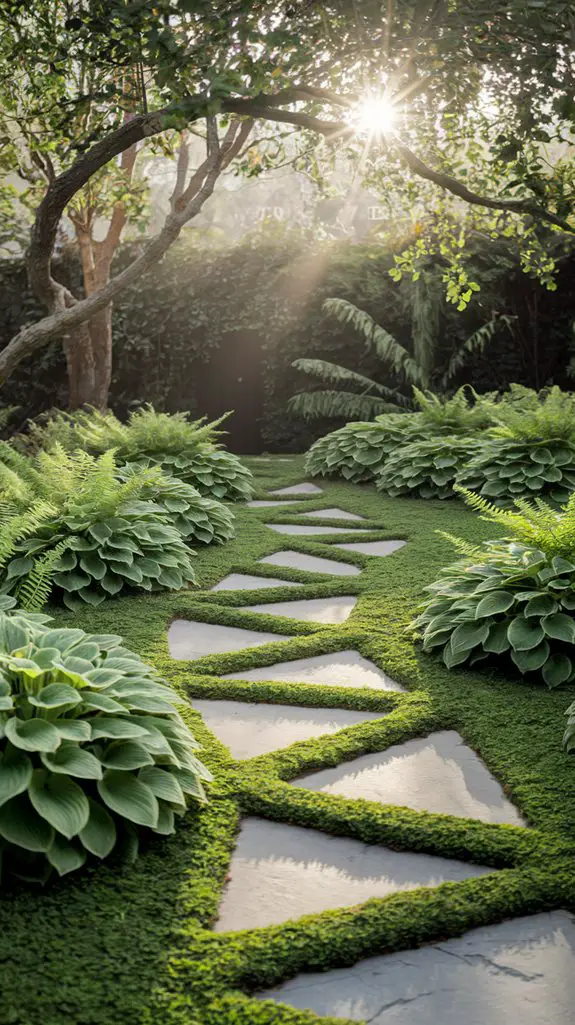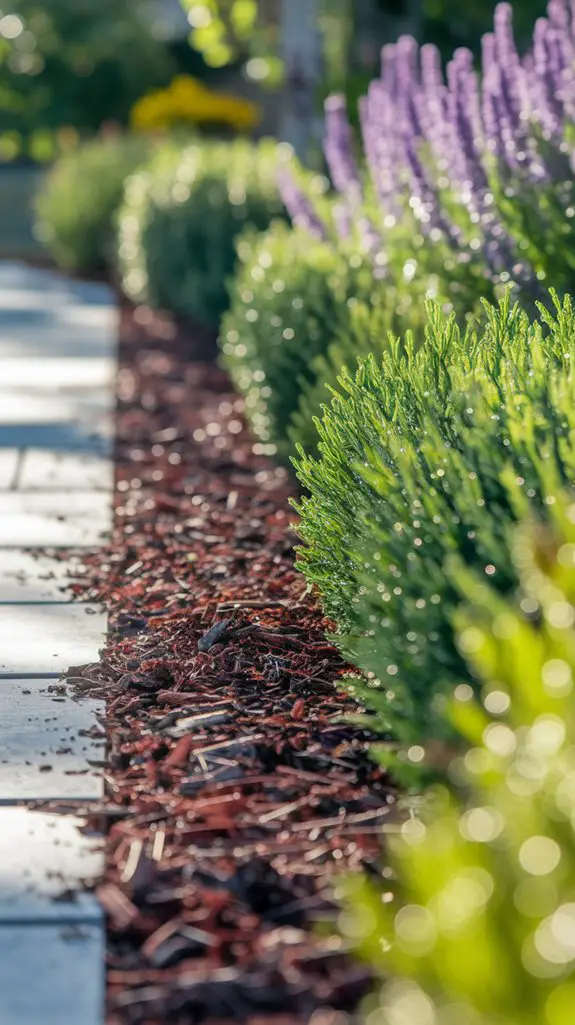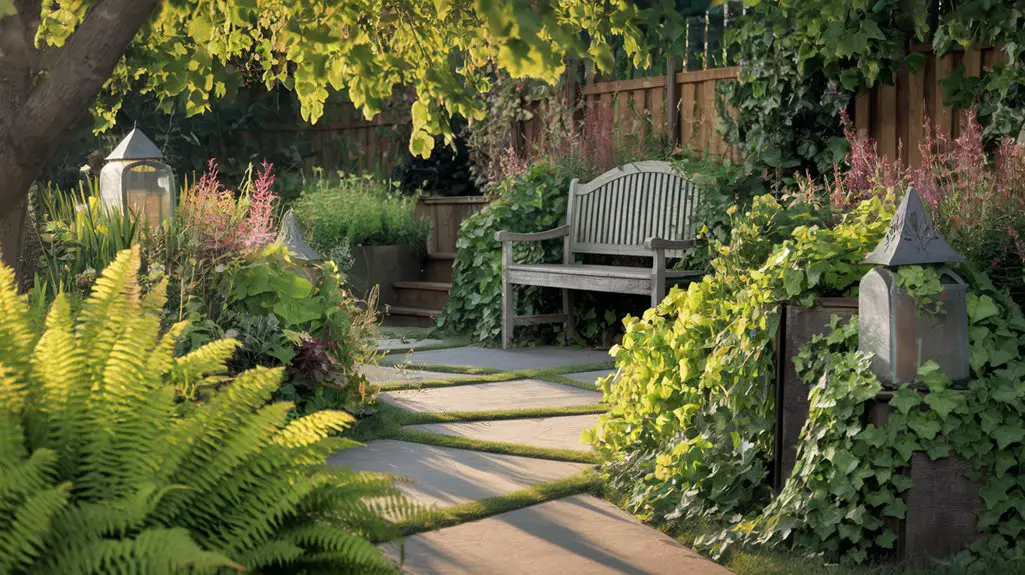Nearly 70% of homeowners view their backyard pathway design as an afterthought, yet well-designed pathways can increase property values by up to 20%. You’ve likely walked through countless gardens where paths feel disconnected from the surrounding landscape—stark concrete slabs cutting through greenery without purpose. Your backyard deserves better than this disjointed approach. By following our expert tips, you’ll transform ordinary walkways into lush, integrated passages that enhance your entire outdoor living experience.
Choose the Right Plants for Pathway Borders
When creating a pathway border, what plants will frame your walkway without causing maintenance headaches? Select low-growing varieties that won’t encroach on your path’s walking space.
Compact perennials like sedum, creeping thyme, or dwarf ornamental grasses provide texture without requiring frequent pruning.
Consider your pathway’s sun exposure—choose drought-tolerant lavender and Russian sage for sunny sections, while hostas and heucheras thrive in shadier spots.
Plant in groups of odd numbers (3, 5, 7) for visual coherence, positioning taller species toward the back and shorter ones near the edge.
For year-round interest, incorporate evergreens like boxwood or dwarf conifers alongside seasonal bloomers.
Space plants properly, accounting for their mature spread to prevent overcrowding that leads to poor air circulation and disease. Additionally, budget-friendly options such as using gravel or mulch can enhance your pathway while keeping costs low.
2. Incorporate Stepping Stones With Ground Cover

Stepping stones paired with ground cover create a harmonious balance between structure and softness in backyard pathways. Select stones that complement your landscape’s aesthetic—natural flagstone for rustic settings or cut pavers for contemporary designs.
Space them at comfortable walking distances (18-24 inches between centers) to accommodate natural stride length.
Choose low-growing ground covers that can withstand light foot traffic. Creeping thyme, Irish moss, or Corsican mint offer resilience while releasing pleasant aromas when brushed. Sedum varieties thrive in sunny locations, while ajuga performs well in shadier spots.
Plant ground cover between stones, allowing 2-3 inches clearance around each stone’s perimeter to prevent overgrowth. You’ll need to trim occasionally to maintain defined edges and prevent covers from obscuring your stepping stones.
This combination provides year-round visual interest while reducing maintenance compared to traditional pathways. Additionally, incorporating artistic mosaic designs can enhance the aesthetic appeal of your stepping stones and create unique focal points in your garden.
3. Select Durable Mulch Materials for Path Edges

Edging your pathway with appropriate mulch materials creates definition while complementing the natural integration you’ve achieved with stepping stones and ground cover.
Select cedar or cypress mulch for their natural pest-repellent qualities and longevity—typically lasting 1-2 years before requiring replacement.
For high-traffic areas, consider heavier hardwood mulches that resist displacement. Pine nuggets offer excellent durability and retain their color longer than shredded varieties.
In wet locations, opt for river rock or crushed stone mulch that won’t float away during heavy rainfall.
Maintain a 2-3 inch depth along path edges to effectively suppress weeds without impeding drainage.
You’ll want to install edging barriers between lawn areas and mulched sections to prevent migration and maintain crisp, defined lines throughout the seasons. Additionally, using low-maintenance landscaping techniques can further enhance your backyard’s aesthetic appeal with minimal effort.
4. Implement Proper Drainage Solutions
Proper drainage remains the cornerstone of any successful pathway installation, preventing water accumulation that can damage materials and create hazardous conditions.
Design paths with a slight crown or cross-slope of 1-2% to direct water away from the walking surface toward planted areas or drainage channels.
Install French drains alongside paths in areas with poor natural drainage or heavy rainfall. These subsurface systems, consisting of perforated pipes surrounded by gravel, efficiently channel water away from your pathway.
For permeable pathway materials like gravel or stepping stones, incorporate a 4-6 inch base of crushed stone beneath to facilitate water movement.
Don’t overlook connection points where pathways meet structures.
Install channel drains at these junctions to prevent water from pooling and potentially damaging your home’s foundation. Additionally, regular maintenance of backyard water features can help ensure that drainage systems remain effective and free from debris.
5. Create Natural Curves for Visual Appeal
While straight paths efficiently connect spaces, gentle curves create a more inviting and aesthetically pleasing backyard journey. Design curves that flow naturally through your landscape, mimicking organic patterns found in nature. You’ll create visual intrigue that draws visitors forward to discover what lies beyond each bend. Incorporating timeless brick pathway designs can further enhance the charm and functionality of your curved pathways.
| Curve Type | Visual Effect | Best Applications |
|---|---|---|
| Gentle S-curve | Subtle, elegant flow | Open lawn areas |
| Meandering | Casual, relaxed pace | Woodland gardens |
| Switchback | Dramatic elevation changes | Sloped landscapes |
| Wide arc | Sweeping, graceful statement | Feature highlighting |
When plotting your curves, use a garden hose to test different configurations before committing. Verify curves aren’t too tight or awkward for comfortable navigation. The radius should accommodate wheelbarrows and foot traffic while maintaining the design’s intended rhythm.
6. Balance Sun and Shade for Plant Health
Path exposure greatly influences both user comfort and plant health along your walkway borders. Assess your garden’s microclimate by tracking sunlight patterns across seasons before finalizing your pathway design.
Position sun-loving perennials where they’ll receive 6+ hours of direct light, while shade-tolerant species should occupy areas beneath tree canopies or alongside north-facing structures.
Consider how vegetation height affects light distribution—taller plants may create beneficial shade pockets for delicate understory specimens. Implement strategic hardscape elements like pergolas or lattice panels to modulate intense afternoon sun where needed.
Remember that proper light balance reduces plant stress, minimizes irrigation requirements, and guarantees consistent visual appeal throughout your pathway. Additionally, incorporating shaded landscaping ideas can enhance the overall effectiveness of your design. Match your plant palette to existing light conditions rather than forcing unsuitable species into challenging exposures for ideal pathway aesthetics and longevity.
7. Establish Regular Maintenance Schedules
Even beautiful pathways deteriorate without consistent care, making scheduled maintenance essential for preserving both function and aesthetic appeal.
Develop a seasonal maintenance calendar that addresses specific needs as they arise throughout the year. Your routine should adapt to climate conditions, material requirements, and surrounding plant growth patterns.
- Spring: Remove winter debris, replace damaged pavers, apply fresh mulch, and prune encroaching vegetation.
- Summer: Monitor irrigation needs, pull weeds weekly, trim pathway edges, and adjust lighting fixtures.
- Fall: Clear fallen leaves promptly, check drainage systems, repair frost heaves, and apply protective sealants.
- Winter: Remove snow carefully using appropriate tools, avoid salt-based ice melters on natural materials, and inspect for structural damage.
Incorporating decorative gravel garden walkway styles can further enhance your pathway’s visual appeal.
Document your maintenance activities to track patterns and anticipate future needs.
8. Add Solar Lighting for Evening Ambiance
Proper maintenance creates the foundation for your pathway’s longevity, but thoughtful lighting transforms it into a 24-hour landscape feature. Solar-powered fixtures offer an energy-efficient solution that doesn’t require complex wiring or increase utility costs.
Position lights strategically at junctions, curves, and elevation changes to highlight architectural elements while ensuring safe navigation. Choose fixtures with consistent lumens output—typically 5-20 lumens for ambient glow and 100+ lumens for task lighting.
Consider color temperature; 2700K-3000K creates warm, inviting atmospheres while 4000K provides clearer visibility. Additionally, properly lighting pathways not only enhances aesthetics but also improves safety during nighttime strolls.
Install stakes on firm ground, avoiding future root zones of expanding plants. Select fixtures with quality photovoltaic cells and weather-resistant housing rated IP65 or higher to withstand seasonal changes.
For cohesive design, match fixture finishes with existing hardscape elements or garden accents.
9. Mix Textures and Heights for Dimension
When designing your backyard pathway, varying textures and heights creates visual interest that flat, one-dimensional landscaping can’t achieve.
Combine contrasting elements strategically along your route to establish depth and guide the eye through your landscape composition.
- Pair low-growing ground covers like creeping thyme with taller ornamental grasses to create layered borders.
- Incorporate hardscape elements of varying heights—strategically place boulders alongside pebbles or combine flat pavers with raised wooden platforms.
- Shift between smooth river rocks and coarse mulch for tactile contrast that’s also functional.
- Use plants with different foliage textures—feathery ferns adjacent to broad-leafed hostas create compelling visual tension.
For maximum impact, limit your texture palette to three primary variations, ensuring the pathway maintains cohesion while still delivering the dimensional complexity that elevates your garden’s design. Additionally, incorporating pathway plants can further enhance the beauty and functionality of your walkways.
10. Install Drip Irrigation for Effortless Care
Maintaining lush plantings along your pathway requires consistent water delivery, which makes drip irrigation an essential element of smart landscape design.
Position soaker hoses or emitter lines beneath mulch, delivering water directly to root zones while minimizing evaporation and runoff.
Configure your system with separate zones based on plant water requirements—drought-tolerant specimens need less frequent cycles than thirsty varieties.
Install a timer with rain sensors to automate watering schedules, adjusting for seasonal needs and weather conditions. This precision conserves water and prevents both underwatering and oversaturation.
For ideal results, incorporate pressure regulators and filters to guarantee consistent flow and prevent clogging.
When properly installed, your drip system will operate virtually unseen, supporting vibrant pathway plantings while reducing maintenance time and water consumption by up to 60%. Additionally, integrating rainwater harvesting systems into your garden can further enhance water efficiency and sustainability.
Conclusion
By implementing these pathway design principles, you’ll transform your yard into a lush oasis that even Victorian garden masters would envy. The combination of thoughtful plant selection, strategic hardscaping, and proper maintenance creates pathways that aren’t just functional but become defining design features. Don’t overlook the power of lighting and irrigation—they’re the technical elements that elevate your garden’s infrastructure while minimizing your ongoing maintenance commitment.




